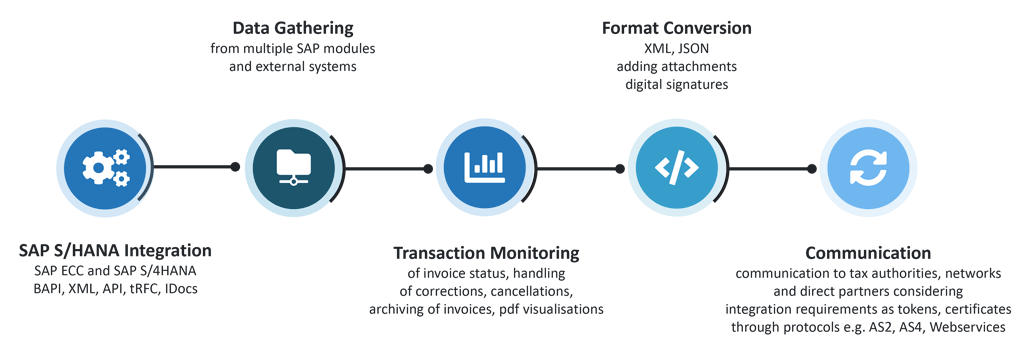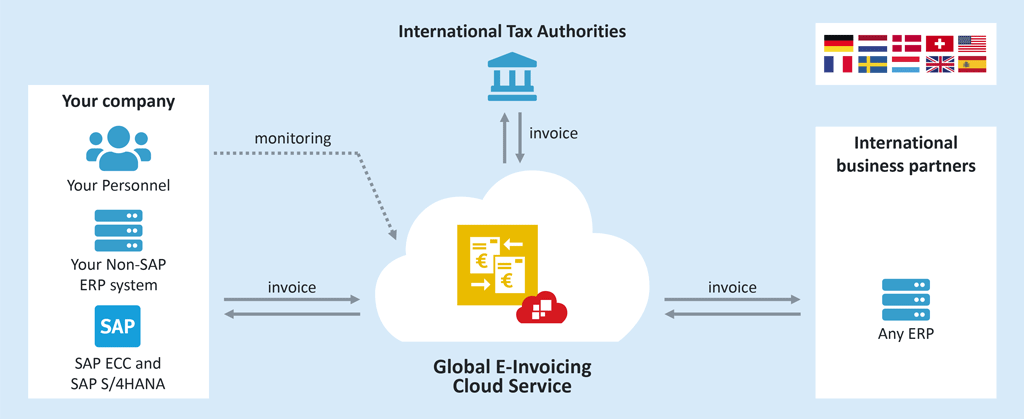Compliance with Global e-Invoicing Mandates and SAP S/4HANA

Migrating to SAP S/4HANA is not being made any easier with all the new e-invoicing legislation due to come in from 2021 and beyond. Dealing with both issues at the same time will be a challenge. However, your e-invoicing processes still need to comply with the newest legislation, even if you are in middle of a SAP S/4HANA project.
Global e-Invoicing legislation and SAP S/4HANA
We are currently observing an increase in mandatory B2B e-invoicing in Europe led by Italy, Spain, Portugal, Hungary, Poland and France. Presumably, other EU countries will follow – just as e-invoicing started and has spread out throughout Latin America within the last decade. This trend is actually being accelerated at the moment due to the global COVID-19 pandemic and the greater need to collect more of the taxes owed to the tax authorities by combating tax evasion and tax carousels more quickly and effectively.
There are plenty of new opportunities and legislation changing or coming up in 2021, for example
- Greece (myDATA)
- Hungary 3.0 (B2T/B2B)
- India (B2B/B2G)
- Italy new XML-Version (B2B/B2G)
- Poland (B2B)
- Portugal (B2G/B2B)
- Serbia (B2G)
- Spain XML updates (B2T)
- Taiwan (B2B/B2G)
The Philippines (B2B), Vietnam (B2B) and France (B2B) also have plans for after 2021.

The challenge is to implement and operate under all this different legislation,
- without having to manage or monitor several different local providers for the countries involved,
- while being able to meet all the legislation for handling electronic inbound and outbound invoices, including new data formats and stipulations on communication channels
- while providing an easy and reliable connection to any ERP system and their respective SAP systems – important for mixed ERP landscapes
- and at the same time, transitioning smoothly from SAP ECC to SAP S/4HANA – or, as an option, from tRFC to API at your own pace
There are a surprising number of ‘mix and match’ ERP landscapes using both SAP and non-SAP systems. Including in globally acting companies.
What is the e-Invoicing process with SAP S/4HANA?
There is a typical set of steps that every e-invoice needs to go through in an SAP ERP. This can be done either through the ECC (ERP Central Component) or S/4HANA. The basic process is the same, regardless of what e-invoicing legislation needs to be considered.

The increasing amount of country-specific e-invoicing legislation being imposed by governments all over the globe is a trend happening at the same time as many companies are needing to adopt SAP S/4HANA . Ensuring that the e-invoicing process above complies with both needs includes a couple of challenges:
- Regardless of whether you take a greenfield or brownfield approach, the SAP ECC and SAP S/4HANA integration patterns need to remain in place. The same is true for an eventual move from tRFC to APIs.
- Data still needs to be received from multiple SAP modules, from non-SAP ERPs and from different deployment locations (S/4HANA can run on-premises or in public or private clouds).
- You still need to be able to monitor, alter and cancel SAP transactions during the changeover
- Format conversion and communication channel depends on the legislation in the respective country, and may require:
- Mapping various data structures into legacy and new target formats
- Adding attachments to invoices
- Certificate-based digital signatures
- Communication to tax authorities, networks e.g. Peppol, and trading partners
- Integration through protocols e.g. AS2, AS4, web services or with tokens
- Local agreements with certified service providers in some countries, signing and archiving the invoice, pdf visualisation and progress reports also need to be included in a full end-to-end system.
Migrating smoothly to SAP S/4HANA while also complying with these new e-invoicing mandates seems like too much at once. Start by breaking this mammoth task into smaller parts, and do the small bits first so you are not overwhelmed.
SAP S/4HANA integration with global e-Invoicing
You need to react fast to new e-invoicing legislation. However, you also need a solution flexible enough to keep legacy and non-SAP systems connected. Depending on the country and the process they stipulate, you may also need to communicate with intermediary government organisations, e.g. GSP for India or PACs in Mexico. If possible, avoid multiple contractual relationships and reduce the complexity of the process by finding a provider who can offer you all the services you need.
The SEEBURGER Business Integration Suite (BIS) combines state-of-the-art integration capabilities with global e-invoicing services including electronic VAT reporting and CTCs. These services can be accessed from whatever ERP source system you may have in place, including SAP ECC and SAP S/4HANA.
SEEBURGER is a certified PEPPOL Access Point Provider and provides a secure global cloud with tier 3+ data centers in Germany, China and USA. It ensures 99.9 % availability and is ISAE 3402 and ISO/IEC 27001 certified.
Why don’t you let us look after your e-invoicing needs, leaving your hands free for other tasks- including the mammoth task of migrating to S/4HANA?

Benefits of Global e-Invoicing and SAP S/4HANA
- Integrate seamlessly into SAP – or any other ERP system – with various SAP adapters and solution extensions
- Monitor e-invoices and progress reports from governmental systems in real-time – either in the cloud, in SAP or in another ERP system.
- Fulfill legal requirements regarding format, digital signature and automated secure communication with the exchange system
- Archive legally compliant e-invoices for multiple countries, including PDF visualizations and progress reports
- Ensure you comply at all times with changing and upcoming e-invoicing legislation by using the Global E-Invoicing Cloud Service
- Avoid individual national providers. This type of patchwork solution ends up becoming costly and increasingly more difficult to manage over time.
This way, migrating to S/4HANA becomes much easier because we have got your back.
Find out more
- Global E-Invoicing Regulations
- Migrate to SAP S/4HANA keeping the B2B/EDI Integration running
- SAP S/4HANA Integration
- How to use SAP S/4HANA with APIs for global e-invoicing
Thank you for your message
We appreciate your interest in SEEBURGER
Get in contact with us:
Please enter details about your project in the message section so we can direct your inquiry to the right consultant.
Written by: Frank Stegmueller
Frank Stegmüller is one of the two corporate information security officers at SEEBURGER and has been with the company since 2008. He has over 25 years of experience in service, support and information security for Enterprise Application Integration, EDI, B2B, MFT, API, ITSM and digital transformation - both on in-house systems and from the cloud. He is involved in the ISO/IEC 27001, ISAE 3402 (SOC 1) Type 2 and TISAX certification for SEEBURGER Cloud Services and knows all about the intricacies of compliant data centre operations in international environments.





